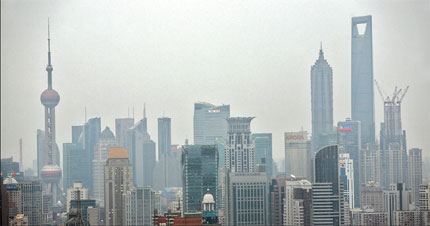China sets tougher air pollution limits
 0 Comment(s)
0 Comment(s) Print
Print E-mail China.org.cn, March 1, 2012
E-mail China.org.cn, March 1, 2012
The State Council, China's Cabinet, passed revised air quality standards on Wednesday which adopts an index for PM2.5, or fine particles 2.5 microns or less in diameter.
Indices for ozone (O3) and concentrations of PM 2.5 will be included in the standards, according to a statement issued by the State Council after a meeting presided over by Premier Wen Jiabao.
 |
|
Highrises from both Puxi and Pudong are seen during overcast weather yesterday in Shanghai. |
This year, monitoring of PM2.5 and O3 will be conducted in four municipalities, 27 provincial capitals, as well as three key regions - east China's Yangtze River Delta, south China's Pearl River Delta, and Beijing-Tianjin-Hebei area in the north, the statement said.
In 2013, the monitoring will be extended to 113 model cities on the state environmental protection list, and to all cities at prefecture level or above in 2015, the statement said.
Air quality across China has remained stable over the past five years and in some cities it has seen improvements with the concentration of SO2 and PM10 reducing, the statement said.
However, the situation remains tough as the total pollutant emissions are still large and air pollution in some regions is serious, it said.
"We need firmer resolution and more effective measures, under higher standards, to remedy air pollution and steadily improve air quality," the statement said.
The country will continue cutting highly-polluting industrial projects in power supply, steel, building materials, metal, petrochemical and chemistry industries, it said.
In the Yangtze River Delta, the Pearl River Delta, and Beijing-Tianjin-Hebei area, China will actively promote clean energy, relocate highly-polluting industrial projects out of populous urban areas and introduce eco-friendly technologies into these projects, it said.
Cities, including Beijing, Shanghai and Guangzhou, have started to monitor PM 2.5. The capital will set up more than 30 PM 2.5 monitoring stations by the end of this year.
In these key areas, the country will raise pollutant emission standards and stop building thermal power plants, steel and cement factories, the statement said.
The government will continue national campaigns of reducing emissions of sulfur dioxide from power plants, steel and petrochemical factories and nitrogen oxides from cement factories.
The State Council also pledged to improve the quality of gasoline and raise the auto exhausts emissions standard. By 2015, vehicles registered before 2005 failing to meet the standard must not be on public roads.






Go to Forum >>0 Comment(s)